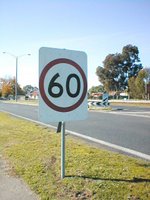2UE KEO and Speed Signs

2UE
KEO time capsule and
That's right Mike.
I'm sure at least a few of your listeners will remember making time capsules from their days at school.
Traditionally that involved taking a few pictures, coins and newspapers, putting them in a weather proof containers and burying it or encasing it in concrete.
But a European initiative is about to take the concept into a whole new dimension.
A French organisation is working with the European Space Agency to create a capsule that would be launched on a rocket and placed in orbit around the Earth.
The capsule, dubbed KEO, would then circle the globe for 50,000 years before descending into the atmosphere in a blaze of sound and lioght for inspection by our great, great great grandchildren.
The project was originally scheduled for 2001, but delays have meant it's now likely to take place next year.
The novel thing about the project is that it has room for a message from every inhabitant on the planet.
Although the capsule is only 80 cm in diametre, the digital age has meant information can be compressed into a very small format.
People are being encouraged to visit the website for the project www.keo.org and leave a message to be placed on board. You can do that up until December 31 this year.
Also on board will be samples of sea water, human blood and soil.
I spoke to Richard Waterhouse an historian from the University of Sydney about the project and he said he hoped Australians would includes messages about anzac day, something that is unique to our culture.
I like this project because it reminds me of the voyager space craft launched in the 1970s which carried on board gold gramophone records.
They were intended as messages about our planet for any extra terrestial life the space probes might enounter.
That's right Mike.
Speeding fines could be a thing of the past within two years thanks to new research being carried out by a Sydney company called Seeing Machines.
They're developing a car computer which will be able to read speed signs by the side of the road and tell you if you're being a lead foot.
If you pre-program it to do so the computer might even be able to automatically apply your brakes to keep you under the speed limit.
The device which could be ready in two years consists of a camera and a micro-processor, a small computer.
You fit it on your windscreen just near the rear view mirror.
As you drive along the camera takes in the surrounding streetscape looking for road signs.
Just like new computers in the United States can identify the faces of terrorists in large crowds, this device will be able to discern speeding signs from the jumble of lights and colours and shapes that you see when you're driving.
When it sees a speed sign it can read the figure and do a number of things with the infomation.
If you want it to it will project a display on your dash, telling you what the speed is in the area you're travelling through.
If you want to be tougher with yourself you will be able to program it to sound an alarm when your speed exceeds the legal limit.
Another option which may eventually be available could be the device applying the brakes to forcibly slow your speed.
The people at Seeing Machines believe the concept could save people thousands in fines and also reduce the risk of speed related injuries and deaths.
By the way motorists in NSW paid out $57 million in fines for speed cameras alone last year.
Also in development overseas are devices to warn you if your car drifts out of its lane and which slam on the brakes if they sense you're about to have a collision......


0 Comments:
Post a Comment
<< Home